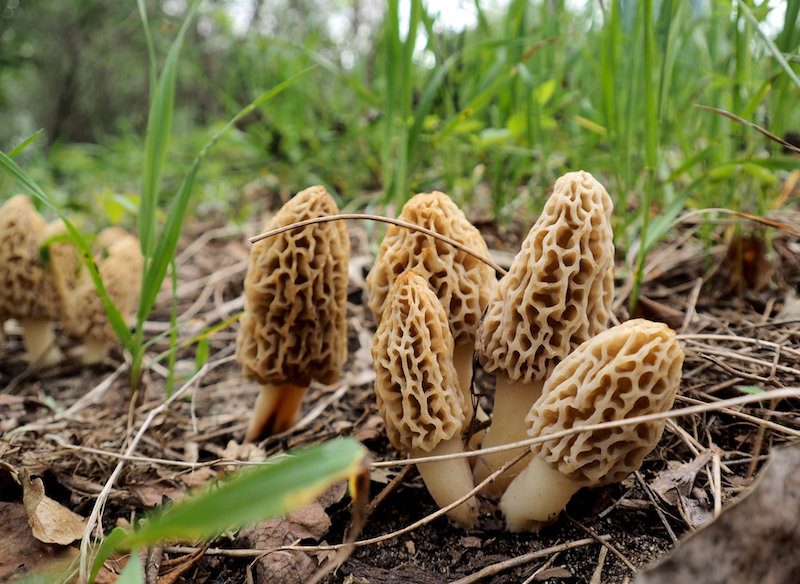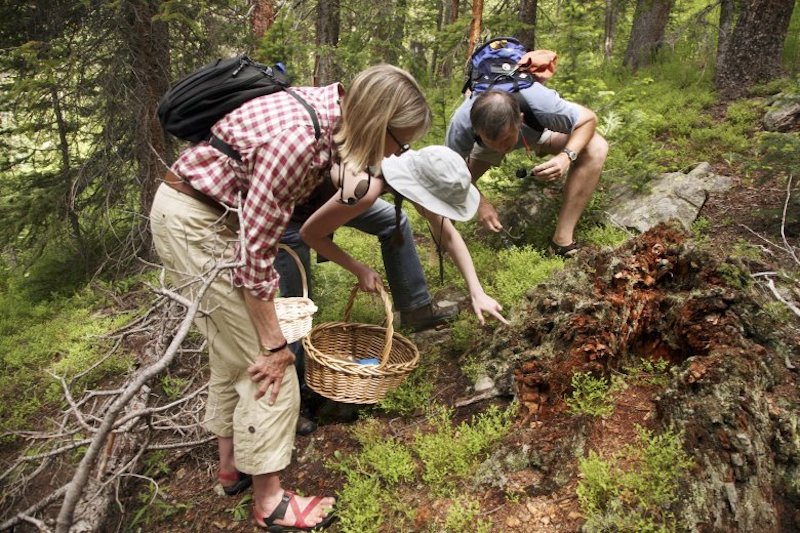Those who love mushrooms usually consider morels their favorite. And if you know someone unsure about mushrooms, they’ll probably like morels.
Morels have a distinct look and unique taste. Some describe the flavor as nutty, meaty and smoky. Others call them indescribable. Morels also refuse to be farmed. They only grow wild, which can make them hard to find. Their flavor, hiding spots and relative rarity make them valuable as gold to people like David Hazlett, co-owner of MorelDawg Mushrooms LLC.
Hazlett hunts relentlessly for morels and even trained his bloodhound Amos to find them. Hazlett also likes sharing tips and insights about morels, and encourages others to hunt them because “it’s plain-old ‘FunGuyz!’” (Note his “fungi/fungus” pun.)

Morels grow from the mycelium underground and can be picked without damaging the root. Photo Credit: NewsLocker
The Spruce Eats website describes morels as “cone-shaped, sponge-textured fungi.” Their color ranges from tan to black with shades of red and brown, and they have a whiteish stem.
Morels are the fruiting body of an underground organism called mycelium, according to Untamedfeast.com. Picking a morel won’t hurt the mycelium, just as picking apples won’t hurt the tree. Mycelium organisms rely on trees to grow and survive, which also makes them hard to farm and cultivate.
And because trees are everywhere, morels can be, too. They’re often found in the fertile soils of pastures, meadows and orchards, but they also flourish around dead and dying trees, especially elm and ash species, Hazlett said.
Morels can be found from March through May, depending on where you seek them. They grow for up to 30 days, but should be picked before they start to rot, mold or decompose.

They grow in clusters, so stay in the same area once you find one. Photo Credit: The Seattle Times
Morel hunters often say these mushrooms are everywhere, but impossible to find. Therefore, start your hunt by finding an experienced guide or mentor to teach you when, where and how to pick morels.
That search will likely take you to a mycology society. “Mycology” is a branch of biology that studies fungi, and mycological societies offer mushrooms walks or mushroom-identification seminars for beginners. Some state wildlife agencies or parks-and-recreation departments also offer mushroom ID classes.
If you can’t find a mycology society, search online for nearby morel-mushroom classes, workshops or certifications. Many universities or parks-and-recreation departments hold seminars about morels.
You can also learn as you go, but make sure your information comes from credible sources. And never eat a mushroom unless you’re certain it’s safe. Morel impostors, “false morels,” are poisonous. Do your homework and log your foraging experiences in a journal until you’re confident identifying morels. Hazlett’s rule is simple: “When in doubt, toss it out.”
Search for morels near dead or dying trees, and be careful picking morels in urban or industrial areas. Mushrooms absorb chemicals, so avoid picking morels near landfills, railroads, roadsides, waste-disposal areas, or sites treated with pesticides and herbicides.
When you find a morel, stop and study your surroundings. You don’t want to step on one hiding under weeds or brush. Use a stick to push vegetation aside. Where you find one morel, you’ll likely find more. Note where you find mushrooms, and the site’s appearance, to help you identify and search similar areas.
To harvest morels, pinch the stem near the ground and pull up. Handle morels carefully because they’re fragile and bruise easily. Place them in mesh bags, a basket or bucket with holes so they can “breathe.” Closed containers or plastic bags promote moisture, which causes molds and bacteria to grow, spoiling your find.
Morels last about a week if stored unwashed in a paper bag inside the fridge. However, Hazlett recommends cooking them within days to ensure they don’t go bad.

Morels are tasty once they’re sautéed or grilled up. Photo Credit: Serious Eats
Morels can be frozen but, like most things, they taste better fresh. Clean morels shortly before cooking them, otherwise the excess water quickly causes rot or mold.
Hazlett’s favorite recipe is grilled-cheese sandwiches with morels. He starts by cooking bacon, and then sautés sliced morels with garlic and onions in the drippings. He transfers the sautéed goodies to paper towels to remove excess grease. He then makes the grilled-cheese sandwich and adds the bacon and sautéed morel mixture to the middle. He cooks the sandwich slowly to brown the bread and melt the cheese.
“It’s so good your tongue will beat you half to death trying to get to it,” Hazlett said.
Don’t eat morels housing bugs, slugs or worms; or if it’s mushy, stinks or looks moldy. Hazlett also warns that some people have mushroom allergies, and others might react badly if they eat mushrooms when drinking alcohol. If you’ve never eaten morels, eat a small portion and wait to see if you react. Once you’re clear, eat some more, but don’t overindulge.
Hazlett also recommends saving an uncooked mushroom sample to take to the doctor if someone gets sick after eating morels.
One more tip: When you’re searching for morels, multi-task by scouting for your next bowhunting hotspot!